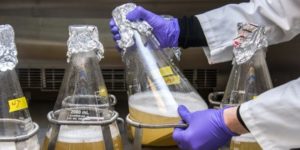APPLICATIONS OF TECHNOLOGY:
- Sunscreen cream
ADVANTAGES:
- Environmentally-friendly sunscreen compound
- High product titer and yield
- Fast-growing microbe host
- Eliminates the use of agricultural plants as feedstocks for Shinorine production
BACKGROUND:
Compounds such as Oxybenzone, Zinc Oxide (ZnO), and Titanium Dioxide, (TiO2) are ubiquitous in many sunscreen creams. However, these compounds have had a significant contribution to coral bleaching. While commercial use of environmentally friendly compounds such as Shinorine are available, low yields from bioproduction in host Porphyra umbilicalis have hindered its widespread use.
Therefore, there is a need for an alternative microbial host that will provide increased yields of Shinorine.
TECHNOLOGY OVERVIEW:
Researchers at Lawrence Berkeley National Laboratory and the Joint BioEnergy Institute have developed a method to engineer Pseudomonas putida KT2440 for production of Shinorine, a mycosporine-like amino acid (MAA). Shinorine has been used as an active ingredient in two commercial sunscreen products (Helioguard 365 and Helionori). This engineered strain is capable of utilizing various carbon sources, including aromatic compounds from lignocellulose hydrolysate as feedstocks. To the researcher’s knowledge, this would be the first report of Shinorine bioproduction in P. putida.
Pathway expression and host engineering enabled Shinorine production in P. putida and initial optimization improved the titer to over 1 g/liter of Shinorine. Additional optimization of the production organism and the production process will improve the product titer.
DEVELOPMENT STAGE:
Proven Principle
PRINCIPAL INVESTIGATORS:
- Ian Sofian Yunus
- Taek Soon Lee
FOR MORE INFORMATION:
STATUS:
Patent pending
SEE THESE OTHER BERKELEY LAB TECHNOLOGIES IN THIS FIELD:
Evolved Pseudomonas putida KT2440 with Enhanced Xylose and Galactose Utilization 2021-054
A CRISPR-Based and Metabolic Modeling Guided Strategy to Maximizing Indigoidine Production 2019-145
